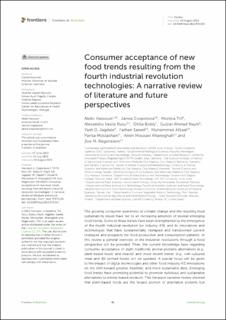| dc.contributor.author | Hassoun, Abdo | |
| dc.contributor.author | Cropotova, Janna | |
| dc.contributor.author | Trif, Monica | |
| dc.contributor.author | Rusu, Alexandru Vasile | |
| dc.contributor.author | Bobiş, Otilia | |
| dc.contributor.author | Nayik, Gulzar Ahmad | |
| dc.contributor.author | Jagdale, Yash D | |
| dc.contributor.author | Saeed, Farhan | |
| dc.contributor.author | Afzaal, Muhammad | |
| dc.contributor.author | Mostashari, Parisa | |
| dc.contributor.author | Khaneghah, Amin Mousavi | |
| dc.contributor.author | Regenstein, Joe M. | |
| dc.date.accessioned | 2023-02-02T09:30:16Z | |
| dc.date.available | 2023-02-02T09:30:16Z | |
| dc.date.created | 2022-11-07T11:42:15Z | |
| dc.date.issued | 2022 | |
| dc.identifier.citation | Frontiers in Nutrition. 2022, 9 (972154), 01-22. | en_US |
| dc.identifier.issn | 2296-861X | |
| dc.identifier.uri | https://hdl.handle.net/11250/3047920 | |
| dc.description.abstract | The growing consumer awareness of climate change and the resulting food sustainability issues have led to an increasing adoption of several emerging food trends. Some of these trends have been strengthened by the emergence of the fourth industrial revolution (or Industry 4.0), and its innovations and technologies that have fundamentally reshaped and transformed current strategies and prospects for food production and consumption patterns. In this review a general overview of the industrial revolutions through a food perspective will be provided. Then, the current knowledge base regarding consumer acceptance of eight traditional animal-proteins alternatives (e.g., plant-based foods and insects) and more recent trends (e.g., cell-cultured meat and 3D-printed foods) will be updated. A special focus will be given to the impact of digital technologies and other food Industry 4.0 innovations on the shift toward greener, healthier, and more sustainable diets. Emerging food trends have promising potential to promote nutritious and sustainable alternatives to animal-based products. This literature narrative review showed that plant-based foods are the largest portion of alternative proteins but intensive research is being done with other sources (notably the insects and cell-cultured animal products). Recent technological advances are likely to have significant roles in enhancing sensory and nutritional properties, improving consumer perception of these emerging foods. Thus, consumer acceptance and consumption of new foods are predicted to continue growing, although more effort should be made to make these food products more convenient, nutritious, and affordable, and to market them to consumers positively emphasizing their safety and benefits. | en_US |
| dc.language.iso | eng | en_US |
| dc.publisher | Frontiers | en_US |
| dc.rights | Navngivelse 4.0 Internasjonal | * |
| dc.rights.uri | http://creativecommons.org/licenses/by/4.0/deed.no | * |
| dc.title | Consumer acceptance of new food trends resulting from the fourth industrial revolution technologies: A narrative review of literature and future perspectives | en_US |
| dc.title.alternative | Consumer acceptance of new food trends resulting from the fourth industrial revolution technologies: A narrative review of literature and future perspectives | en_US |
| dc.type | Peer reviewed | en_US |
| dc.type | Journal article | en_US |
| dc.description.version | publishedVersion | en_US |
| dc.source.pagenumber | 01-22 | en_US |
| dc.source.volume | 9 | en_US |
| dc.source.journal | Frontiers in Nutrition | en_US |
| dc.source.issue | 972154 | en_US |
| dc.identifier.doi | 10.3389/fnut.2022.972154 | |
| dc.identifier.cristin | 2069899 | |
| cristin.ispublished | true | |
| cristin.fulltext | original | |
| cristin.qualitycode | 1 | |

